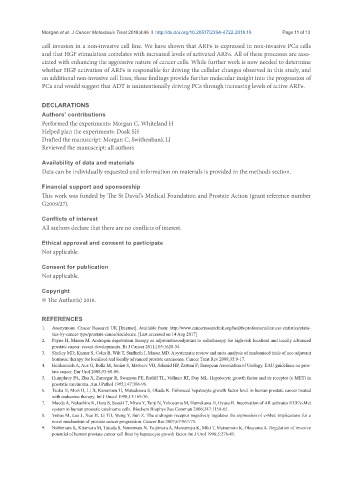Page 555 - Read Online
P. 555
Morgan et al. J Cancer Metastasis Treat 2018;4:46 I http://dx.doi.org/10.20517/2394-4722.2018.19 Page 11 of 13
cell invasion in a non-invasive cell line. We have shown that ARF6 is expressed in non-invasive PCa cells
and that HGF stimulation correlates with increased levels of activated ARF6. All of these processes are asso-
ciated with enhancing the aggressive nature of cancer cells. While further work is now needed to determine
whether HGF activation of ARF6 is responsible for driving the cellular changes observed in this study, and
on additional non-invasive cell lines, these findings provide further molecular insight into the progression of
PCa and would suggest that ADT is unintentionally driving PCa through increasing levels of active ARF6.
DECLARATIONS
Authors’ contributions
Performed the experiments: Morgan C, Whiteland H
Helped plan the experiments: Doak SH
Drafted the manuscript: Morgan C, Swithenbank LJ
Reviewed the manuscript: all authors
Availability of data and materials
Data can be individually requested and information on materials is provided in the methods section.
Financial support and sponsorship
This work was funded by The St David’s Medical Foundation and Prostate Action (grant reference number
G2009/27).
Conflicts of interest
All authors declare that there are no conflicts of interest.
Ethical approval and consent to participate
Not applicable.
Consent for publication
Not applicable.
Copyright
© The Author(s) 2018.
REFERENCES
1. Anonymous. Cancer Research UK [Internet]. Available from: http://www.cancerresearchuk.org/health-professional/cancer-statistics/statis-
tics-by-cancer-type/prostate-cancer/incidence. [Last accessed on 14 Aug 2017]
2. Payne H, Mason M. Androgen deprivation therapy as adjuvant/neoadjuvant to radiotherapy for high-risk localised and locally advanced
prostate cancer: recent developments. Br J Cancer 2011;105:1628-34.
3. Shelley MD, Kumar S, Coles B, Wilt T, Staffurth J, Mason MD. A systematic review and meta-analysis of randomised trials of neo-adjuvant
hormone therapy for localised and locally advanced prostate carcinoma. Cancer Treat Rev 2009;35:9-17.
4. Heidenreich A, Aus G, Bolla M, Joniau S, Matveev VB, Schmid HP, Zattoni F; European Association of Urology. EAU guidelines on pros-
tate cancer. Eur Urol 2008;53:68-80.
5. Humphrey PA, Zhu X, Zarnegar R, Swanson PE, Ratliff TL, Vollmer RT, Day ML. Hepatocyte growth factor and its receptor (c-MET) in
prostatic carcinoma. Am J Pathol 1995;147:386-96.
6. Tsuka H, Mori H, Li B, Kanamaru H, Matsukawa S, Okada K. Enhanced hepatocyte growth factor level in human prostate cancer treated
with endocrine therapy. Int J Oncol 1998;13:169-76.
7. Maeda A, Nakashiro K, Hara S, Sasaki T, Miwa Y, Tanji N, Yokoyama M, Hamakawa H, Oyasu R. Inactivation of AR activates HGF/c-Met
system in human prostatic carcinoma cells. Biochem Biophys Res Commun 2006;347:1158-65.
8. Verras M, Lee J, Xue H, Li TH, Wang Y, Sun Z. The androgen receptor negatively regulates the expression of c-Met: implications for a
novel mechanism of prostate cancer progression. Cancer Res 2007;67:967-75.
9. Nishimura K, Kitamura M, Takada S, Nonomura N, Tsujimura A, Matsumiya K, Miki T, Matsumoto K, Okuyama A. Regulation of invasive
potential of human prostate cancer cell lines by hepatocyte growth factor. Int J Urol 1998;5:276-81.

